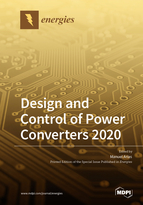Design and Control of Power Converters 2020
A special issue of Energies (ISSN 1996-1073). This special issue belongs to the section "F: Electrical Engineering".
Deadline for manuscript submissions: closed (10 December 2020) | Viewed by 27624
Special Issue Editor
Interests: AC–DC and DC–DC power converters; battery equalizers; UPS; LED lighting; DC micro-grids and solid state transformers
Special Issues, Collections and Topics in MDPI journals
Special Issue Information
Dear Colleagues,
In terms of research, power electronics is one of the most prolific fields in the world of electronics. One of the main reasons for this is its relevance for present-day society, which is increasingly concerned with energy saving and greener energy production. This scenario constitutes a powerful catalyst for research, not only boosting the amount of interesting ideas, solutions, and studies, but also the number of topics that emerge under the umbrella of power electronics. This can be seen in the fact that well-established research topics, as varied as renewable energies, battery management, and electric traction coexist—or even merge—with more recent topics, such as LED lighting or micro- and nano-grids. Moreover, these topics can be considered as established when compared to others like wide band-gap devices and electric vehicles, where research is still incipient.
In all of the aforementioned topics, in addition to others, the “design and control of power converters” plays a key role. In this Special Issue, representative papers that focus on well-established topics, as well as more recent ones, are sought. This mixture will unquestionably foster new ideas for readers and will help researchers detect solutions that can be migrated from one topic to another, making this Special Issue a relevant milestone for any power electronics engineer.
Prof. Dr. Manuel Arias Pérez de Azpeitia
Guest Editor
Manuscript Submission Information
Manuscripts should be submitted online at www.mdpi.com by registering and logging in to this website. Once you are registered, click here to go to the submission form. Manuscripts can be submitted until the deadline. All submissions that pass pre-check are peer-reviewed. Accepted papers will be published continuously in the journal (as soon as accepted) and will be listed together on the special issue website. Research articles, review articles as well as short communications are invited. For planned papers, a title and short abstract (about 100 words) can be sent to the Editorial Office for announcement on this website.
Submitted manuscripts should not have been published previously, nor be under consideration for publication elsewhere (except conference proceedings papers). All manuscripts are thoroughly refereed through a single-blind peer-review process. A guide for authors and other relevant information for submission of manuscripts is available on the Instructions for Authors page. Energies is an international peer-reviewed open access semimonthly journal published by MDPI.
Please visit the Instructions for Authors page before submitting a manuscript. The Article Processing Charge (APC) for publication in this open access journal is 2600 CHF (Swiss Francs). Submitted papers should be well formatted and use good English. Authors may use MDPI's English editing service prior to publication or during author revisions.
Keywords
- Low-power and high-power converters
- New control techniques in power electronics
- Very fast response converters and controls
- Aerospace applications
- Converters based on wide-band-gap devices
- Reliability-oriented design and control
- Lighting
- Motor drives
- Renewable energies
- Power quality and utility applications
- Solid State transformers
- Micro- and nano-grids
- Electric vehicles
- Battery management systems and battery equalizers






